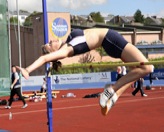Copyright © University of Cambridge. All rights reserved.
'Jumping' printed from https://nrich.maths.org/
Show menu
Why do this problem?
This problem uses the context of sports training to offer opportunities for learners to explore division and/or multiplication. Pupils will be required to consider the relationships between multiplication, division and fractions, which will help reveal their level of understanding.
Possible approach
Depending on pupils' previous experiences and skills, it might be helpful to pose a few questions involving finding 'half as much again' before going on to the problems as posed. You could encourage pupils to record their own long jump results during a PE lesson, then list some of these on the board when you return to class. Pick out one length and ask the group how far that
child would have jumped if s/he had jumped half as far again. Invite pairs to work on finding a solution and then the ensuing discussion will allow you to assess how well they have understood the idea. You can pose a few similar questions to give them more practice, should they need it.
You can then introduce them to the questions as stated in the problem which require children to 'work backwards'. Again, encourage them to talk to a partner or work in a small group and give them free choice of equipment/tools that they feel would help their calculations.
Allow plenty of time for them to come together to discuss their methods. You may like to have picked out some pairs/groups and warned them in advance that you'd like them to explain what they've done to everyone else. Try to sit back during this discussion so that class comments on the explanations rather than you. This may well prove a good assessment opportunity from your
perspective.
You may like to conclude by asking the children which method they would use if they were now given a similar problem. There are likely to be a range of responses, so encourage each pupil to give reasons for their choice.
Key questions
Tell me about the two jumps.
How did you get to your answer?
Possible extension
Ask children to create questions (to which they know the answers) that are similar, but also extend the simple phrase to one involving more difficult fractions. e.g. "only reached two thirds of what they did the first time" or "a third as much again".
Possible support
Some pupils may find it helpful to use some material to count with, for example a paper number line that can be cut up can be useful.

